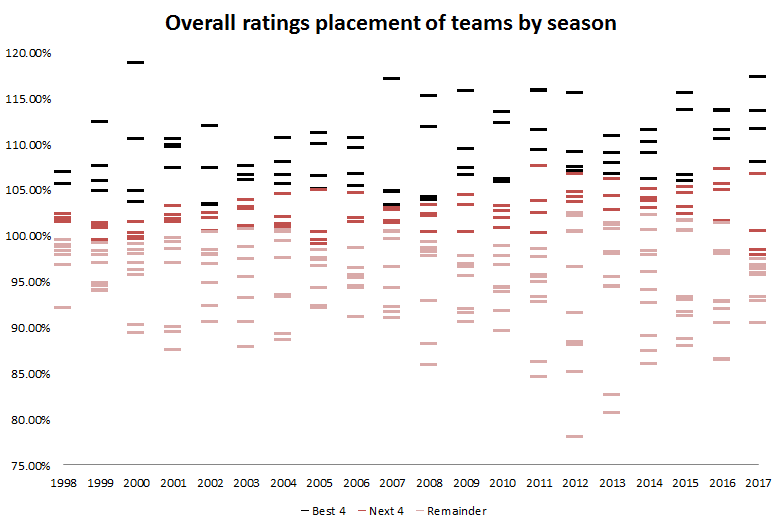Currently the 2017 season of the AFL looks like a small number of really good teams and then an unusually long tail of ordinary but not terrible teams. Only six clubs currently sit above the competition average on our combined rating covering midfield, offensive and defensive strength. By contrast, the bottom ranked side (Carlton) is closer to the pack than any team has finished in our ratings for any season since 2009 (Melbourne).

Adelaide, GWS and to a lesser extent Port Adelaide currently look well ahead of every other team in terms of their strength, with Geelong and Richmond also looking pretty solid on the back of great output in one part of the ground. The gap from Richmond (5th) to Melbourne (6th) is currently larger than the gap from Melbourne back to Sydney (15th). Likewise, the gap from Adelaide in first to Richmond in fifth is greater than the gap between Melbourne in sixth and Carlton in last.
We should note that it is early days and big movements can happen across a season as opponent strengths become more reliable and we get a larger sample of games. However, the question may simply be whether the lead group contains three, four, or five members and whether anyone can break out of the peloton composed of at least half the competition.
Last year HPN drew a line at 105% as the lowest a side could be and still be a viable premiership chance, which was based on the previous 20 years of ratings. The Bulldogs, a historical outlier, only just scraped by this barrier on an unadjusted basis in 2016, and were just under it on an opposition adjusted basis. On this basis all of the top five teams still remain viable premiership chances – but we note (yet again) that the season is very young, and a lot will change between now and September.
Some teams pop out of this as not really getting results commensurate with their apparent strength. The Demons sit 6th here but only have won two games, having let three close games slip, and been unlucky with structure-wrecking midgame injuries. The Bulldogs, now at 4-1, continue to be unimpressive.
By contrast, perhaps Richmond and Fremantle, popularly seen as over-performing or lucky so far, roughly deserve their respective 5-0 and 3-2 records.
This season shape as it stands right now is an intriguing one, as we can see comparing to past completed seasons. The dense cluster around 95% is pronounced:

It would be relatively unusual for the season to finish with no team below 90% of the competition average. We should expect some stragglers to fall further behind to where strugglers end up most years.
Similarly, Adelaide are currently tracking as strongly as Geelong of 2007 and nearly approaching Essendon of 2000. They do look very good right now, but if they can sustain these offensive, defensive and midfield efficiencies across a season, it would make them one of the all-time great teams and be a massive story in its own right, especially if the Giants don’t manage to stay with them.
In terms of specific line strengths, right now as we look at our team ratings, only the top three sides are rated above average in all three areas. Adelaide are continuing 2016’s historic performance in offensive efficiency but have added a greater dominance of inside-50 opportunities, meaning if they don’t have dominant midfielders then at least they are still dominating in the midfield area. Port Adelaide and Geelong both look like they’re strongest through the midfield as well. Richmond and Geelong also both have one line (Defence and Offense, respectively) sitting at least 10% above average.
Currently it looks as though Essendon have the worst midfield, Collingwood the worst forward line and Gold Coast the worst defence, but none of those sides shape as the worst team overall. Those three teams are counterbalanced by other lines – Essendon have defended well, Collingwood’s midfield looks strong, and the Suns have been strong between the arcs if not within them.
Only Sydney, Hawthorn, Carlton and Fremantle are below average across the board so far this year and of those, Sydney’s defence, Hawthorn’s defence and Fremantle’s midfield are above 99%, so pretty much on average.
Some sides with pretty uneven strength include North Melbourne, West Coast and Brisbane. North have exhibited a pretty good defence, meaning they haven’t conceded scores from inside-50s too often in spite of their strong opponents. Rather it’s the sheer quantity of inside-50 opportunities allowed (identified in the midfield strength rating) which have brought them undone. The Eagles’ offensive efficiency has been their saving grace, while Brisbane’s offence has been league average but undone by the sheer lack of opportunities delivered by their midfield.

Great analysis as always. There is so much to consider
I’ve been fascinated by two strategies employed by teams this year:
1) Western Bulldogs transformation from an inside team to an outside team ie. moving on from a strength and
2) Geelong transforming their whole game plan to revolve around effective forward entries (eg. look at Dangerfield’s i50 entries this year).
Geelong has gone further and look to be targeting very specific areas to take their shots on goal from. When this extra data is added it shows the accuracy of Geelong isn’t an anomaly.
Their natural tactic is to get the ball I50 quick however, I’ve seen them on numerous occasions reboot from just outside forward 50 to inside their back 50 in what looks like a considered tactic to spread the opposition defensive structure away from their goals.
Does your midfield number take into account efficiency? As I would think the midfield numbers for Geelong last year versus last year would be significantly different, but this years has proven much more fruitful for the forward line.